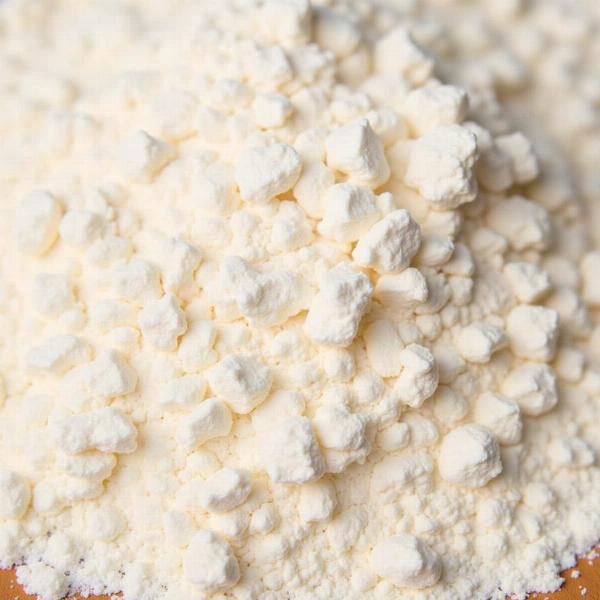Maida meaning in Hindi is मैदा (maidā). This seemingly simple translation opens a world of culinary and cultural significance in India. Understanding maida’s meaning goes beyond just knowing its Hindi equivalent; it involves appreciating its role in Indian cuisine, its nutritional profile, and even its historical context. This article explores the various facets of maida, from its production process to its diverse applications in Indian cooking and baking.
What Exactly is Maida?
Maida is a finely milled, refined wheat flour commonly used in various Indian dishes, particularly in North Indian cuisine. It’s known for its soft texture and white color, resulting from the removal of the bran and germ during processing. This gives maida a longer shelf life but also reduces its nutritional value compared to whole wheat flour (atta). Maida is the key ingredient in many beloved Indian staples, from fluffy naan and parathas to crispy samosas and flavorful sweets.
 Close-up of Maida Flour
Close-up of Maida Flour
Maida vs. Atta: Key Differences
While both maida and atta originate from wheat, their processing methods create significant differences. Atta, or whole wheat flour, retains the bran and germ, giving it a coarser texture and a slightly brownish hue. This makes atta richer in fiber and nutrients. Maida, on the other hand, undergoes extensive refining, resulting in a finer texture and a whiter appearance, but with fewer nutrients. Choosing between maida and atta often depends on the specific culinary application and individual dietary preferences.
Culinary Uses of Maida in Indian Cuisine
Maida plays a starring role in a wide array of Indian dishes, both savory and sweet. Its fine texture lends itself perfectly to creating soft and fluffy breads like naan, bhatura, and kulcha. It’s also used in making crispy snacks like samosas, kachoris, and pakoras. In the realm of sweets, maida is the base for countless delicacies, including gulab jamun, jalebi, and various types of halwa.
Nutritional Profile of Maida
While maida offers a pleasing texture and versatility in cooking, it’s important to be aware of its nutritional profile. The refining process strips away much of the fiber, vitamins, and minerals present in whole wheat. Consequently, maida is lower in fiber and essential nutrients compared to atta. Excessive consumption of maida-based products may contribute to weight gain and other health issues.
Maida Meaning in Different Indian Languages
While “maida” is commonly understood throughout India, regional variations exist. In some South Indian languages, maida might be referred to as “refined flour” or by other local names. maida in hindi meaning helps bridge this linguistic gap and allows for a clearer understanding across different regions.
How is Maida Made?
Maida is produced by milling wheat grains after removing the bran and germ. This process involves multiple stages of grinding and sifting to achieve the desired fine texture. The resulting flour is then bleached to achieve its characteristic white color.
Is Maida Healthy?
“Maida in moderation can be part of a balanced diet, but it shouldn’t be a staple,” says Dr. Anita Sharma, a renowned nutritionist in Delhi. “Opting for whole wheat alternatives whenever possible is always the healthier choice.” Replacing maida with atta in some dishes can be a simple way to increase your fiber and nutrient intake.
Conclusion: Maida’s Place in Indian Cuisine
Maida, with its Hindi meaning मैदा, is undeniably an integral part of Indian culinary heritage. From fluffy breads to delectable sweets, maida has a unique place in Indian kitchens. While it’s essential to be mindful of its nutritional profile, understanding its properties and culinary applications allows for a more informed and balanced approach to incorporating it into one’s diet. maidam meaning in hindi offers a deeper understanding of this versatile ingredient.
FAQ:
- What is the difference between maida and all-purpose flour? Maida is similar to all-purpose flour but is often bleached and has a slightly lower protein content.
- Can I substitute maida with atta in all recipes? While substitutions are possible, the results may vary. Atta’s higher fiber content can alter the texture and taste. plain flour meaning in hindi will also help understand the subtle differences.
- Is maida gluten-free? No, maida contains gluten, making it unsuitable for individuals with gluten intolerance or celiac disease.
- Where can I buy maida? Maida is readily available in most grocery stores and supermarkets in India.
- How should I store maida? Store maida in an airtight container in a cool, dry place to prevent it from spoiling. maidan meaning in hindi also has a related context you might find interesting.
- What are some healthier alternatives to maida? Whole wheat flour (atta), multigrain flour, and other whole grain options are healthier alternatives.
- Does maida have any nutritional value? While lower in nutrients than whole wheat, maida does provide some carbohydrates and a small amount of protein. fertile plains meaning in hindi offers a glimpse into the agricultural richness of India.
Meaning-Hindi.in is your trusted partner for professional Hindi translation services, catering to diverse needs from business and legal documents to technical manuals and website localization. Our team of expert linguists ensures accurate and culturally sensitive translations. We also specialize in educational and academic translations, offering fast and reliable services for all your language needs. Contact us today for a free quote! Email: [email protected], Phone: +91 11-4502-7584. Meaning-Hindi.in is here to help you bridge the language gap.